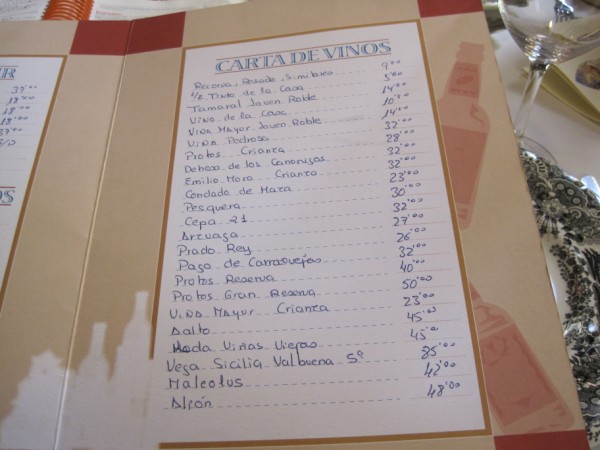Entro a comer en un buen restaurante de Valladolid capital.
Tenemos claro que vamos a tomar un lechazo y una ensalada mixta.
Le pido al camarero la carta de vinos.
Le echo un vistazo de arriba abajo.
Hay 23 vinos en la carta. Trato de imaginarme los enormes esfuerzos que cada una de las bodegas presentes en la carta han tenido que hacer para conseguir hacerse un hueco en este prestigioso restaurante de Valladolid.
En muchos casos, la labor de venta de la bodega acaba ahí.
Siendo importante que compren tu vino, no lo es menos que te vendan. Porque se trata de generar rotación. Todos los negocios se hacen mayores de edad, no cuando te compran por primera vez, sino cuando hay repetición de compra. Esto indica que todo el proceso de venta ha funcionado y que hemos cumplido con las expectativas del consumidor. Por ello, el cliente satisfecho repite compra.
Se trata de que no solo te compre el restaurante sino que te compre el cliente del restaurante. Que éste quede satisfecho y hable bien de tu producto y del servicio que ha recibido. Que, al agotarse tu producto haya un nuevo pedido en tu bodega.
¿Dispone el restaurante de un sommelier? ¿Qué porcentaje de las ventas del restaurante surgen por recomendación del restaurante? ¿Influye estar el primero o de los primeros en la carta? ¿Influye que la carta de vinos esté repartida en diversas páginas? ¿Marca un margen exacto de recargo sobre el precio de coste? ¿Aplica un margen distinto a determinadas marcas por tener mucho más stock? ¿No deberíamos de seguir trabajándonos a los clientes para que, no solo nos compren sino que nos vendan?
Y ahora. Te cedo el sitio. Ya no eres bodeguero. Eres el cliente que está en el restaurante y se va a comer el lechazo y la ensalada. ¿Qué vino pedirías de los que hay en la carta y por qué?
Tenía un profesor de Marketing que decía que todo lo que ocurre en el mercado es sencillísimo y evidente. Evidente significa que hay que verlo. Y cuanto más cerca se esté del proceso de compra mejor. ¿Y cuál es el momento más importante? Cuando el consumidor final realiza el acto de compra. Ese es el momento culminante. Todo lo que hagan los intermediarios, comprando para luego vender es también muy importante. Pero nada funciona a medio y largo plazo si no hay un consumidor que decida o se deje aconsejar en el momento de la compra.
Soy todo oídos. Por favor explícame qué vino has elegido y por qué, que quiero aprender.
Post en inglés: The miracle of selling wine in a restaurant
I get into a good restaurant to have lunch in Valladolid. We know for sure we want to have lamb and mixed salad. I ask the waiter to bring the Wine Menu. I take a look at it and I see it offers 23 wines. I come to understand the great efforts the Wineries represented in this Menu had to make in order to be present in such a prestigious restaurant in Valladolid. In many cases, selling activities of Wineries finish here.
There is no doubt that not only it is important that others buy your wine, but also the fact it is actually sold. The main aim is to create rotation. All businesses become mature, not only when your product is purchased for the first time, but also when it is purchased for a second. This is a sign that shows the selling process has worked and that we have met the customer’s expectations. The truth is that a satisfied customer always buys your product again.
The main objective is that not only the restaurant purchases your product, but also the restaurant customers –customers must be satisfied with both the product and the service received. And another goal is that the restaurant makes a new order of your product when they run out of stock.
Does the restaurant have a sommelier? What is the restaurant sales percentage related to restaurant recommendations? Is there any influence in being at the top of the wine list? Does it have any influence the fact the wine menu has several pages? Does the restaurant have a precise margin of profit over the cost price? Do they apply a different margin of profit according to specific brands for stock reasons? Shouldn’t we continue focusing on the client to ensure that not only do they buy our products but also sell them?
And now it is your turn. You are not a wine producer anymore. You are the customer sitting at the restaurant and you are about to eat lamb and salad. What wine would you order from the ones in the menu and why?
I had a Marketing Professor who used to say that everything happening in the market is simple and evident. Evident means that it must be seen, and the closer you are to the purchase process, the better. What is the most important moment? No doubt it is the moment when the final consumer buys the product –this is the highest point. All the actions carried out by third parties to purchase and sell are also important. But nothing works in the medium and long term if there is not a consumer to decide or to accept being advised at the moment of purchase.
I am all ears. Please tell me which wine you chose and why –I want to learn.
This post in Spanish: El milagro de la venta de vino en un restaurante

